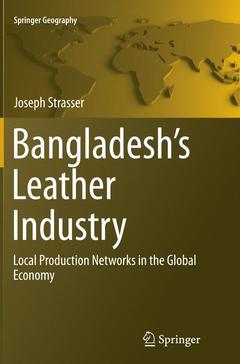Description
Bangladesh's Leather Industry, Softcover reprint of the original 1st ed. 2015
Local Production Networks in the Global Economy
Springer Geography Series
Author: Strasser Joseph
Language: English
Subjects for Bangladesh's Leather Industry:
Publication date: 10-2016
Support: Print on demand
Publication date: 09-2015
Support: Print on demand
Description
/li>Contents
/li>Comment
/li>
This study provides an overview of how the Bangladeshi leather value chain is organised and governed. It analyses how the leather processing and leather goods/footwear subsectors are integrated into the global market and to what extent informal arrangements including illicit practices are conducive to global market entry. Power relations are dissected along the value chain, in order to analyse how local producers adapt to upholding competitiveness. The results of the work show the need to devise upgrading strategies which pay heed to the reality of informal dynamics in a global value chain (GVC) to improve the local producers? competitiveness. The GVC perspective was combined with considerations on upgrading, subcontracting, middlemen and informality to adequately analyse the complexity of the transactions in the chain. The data of this study are drawn from empirical field studies in Dhaka, Bangladesh and other sections of the international leather value chain during the time period of 2010 to 2014. A qualitative research approach was complemented with quantitative methods.
Introduction.- Conceptual Approaches.- Methodology.- The Leather Industry in Bangladesh.- The Leather Value Chain in Bangladesh – Results of a Qualitative Analysis.- Conclusion.- Appendices.
First comprehensive study of Bangladesh's leather industry within economic geography
A special chapter on the festival of sacrifice (Eid-ul-Azha) informs about its impact on the leather industry
Shows how and why leather processors turn to informal (and illicit) practices and strategies in three areas that are crucial for global market entry: chemical imports, environmental regulation, leather exports
A thorough analysis of development constraints and strategies to improve the industry's competitiveness provides local authorities and development organisations with points of intervention
Includes supplementary material: sn.pub/extras




